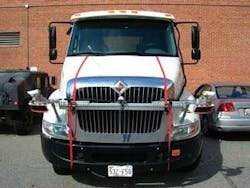COLLISION AVOIDANCE: NIST tests automobile crash-warning system
Engineers at the National Institute of Standards and Technology (NIST; Boulder, CO) have developed and tested a laser-based ranging system to assess the performance of automobile collision-warning systems. Researchers in industry and at the U.S. Department of Transportation (DOT) will be able to use the NIST technology to develop and commercialize safety systems that alert drivers to multiple potential crash hazards—from forward and side collisions, as well as from running off the road. Such warning systems could substantially decrease the number and severity of motorist injuries and fatalities.
To evaluate the performance of crash warning systems, which generally use radar, researchers needed an accurate measurement tool based on entirely different principles. NIST researchers developed an independent measurement system consisting of a camera and microphone in the cab to detect the driver warning, a suite of calibrated cameras to measure the distance to lane boundaries, and laser scanners to measure the distance to obstacles ahead and to the side of the vehicle. The system was mounted on cars or trucks with trailers and required no modifications or connections to the warning system being tested. The NIST system was able to detect an object 0.8 m in size up to 60 m away at speeds up to 25 m/s (a 33 in. object up to 197 ft away at speeds up to 56 mph.)
Two laser scanners were mounted on the outside front corners of the vehicle. Each scanner emitted pulses from four infrared laser diodes and measured the return time to gauge distances to nearby objects. A 10 Hz rotating mirror swept the laser pulses around a 300° horizontal field of view. The four laser diodes were oriented at 1° increments above and below the horizon to provide a 4° vertical field of view to enable the scanner to pick up obstacles when the vehicle pitches.
The NIST researchers used the measurement system to evaluate the performance of two warning systems built by the DOT’s Integrated Vehicle-Based Safety Systems (IVBSS) program for a light vehicle and a heavy truck. Researchers collected data in representative crash-imminent driving scenarios in which a crash warning should be issued as well as scenarios that might cause a system to issue a false alarm. Both systems passed most of the more than 30 tests conducted this fall in East Liberty, OH, and Dundee, MI. However, the testing revealed some warning system problems in detecting whether forward vehicles were in-lane or out on curves or during lane changes. Some delays in warning also resulted in test failures.
“The amount of reaction time appears to be a tradeoff against false alarms,” says Sandor Szabo, testing engineer at NIST. “The further out the system looks, the greater the chance of picking up out-of-path objects like vehicles in adjacent lanes on curves that are not threats to the driver.” Such problems are common in automotive crash warning systems that must operate in real-time, at highway speeds, and use multiple low-cost sensors to measure complex three-dimensional scenes.
Some luxury cars currently offer warning systems that focus more on reducing injuries then actual crash prevention. “Partly this is an issue of liability and who will accept the blame when a system fails to prevent a crash,” says Szabo. “But the other issue is not to annoy the driver with unnecessary warnings.” Warning-system developers reduce false alarms by reducing the detection range, which in turn reduces available driver reaction time. However, safety engineers can put that extra time to use by designing cars that predeploy airbags and the tension on seatbelts to reduce injuries and make cars safer.

Valerie Coffey-Rosich | Contributing Editor
Valerie Coffey-Rosich is a freelance science and technology writer and editor and a contributing editor for Laser Focus World; she previously served as an Associate Technical Editor (2000-2003) and a Senior Technical Editor (2007-2008) for Laser Focus World.
Valerie holds a BS in physics from the University of Nevada, Reno, and an MA in astronomy from Boston University. She specializes in editing and writing about optics, photonics, astronomy, and physics in academic, reference, and business-to-business publications. In addition to Laser Focus World, her work has appeared online and in print for clients such as the American Institute of Physics, American Heritage Dictionary, BioPhotonics, Encyclopedia Britannica, EuroPhotonics, the Optical Society of America, Photonics Focus, Photonics Spectra, Sky & Telescope, and many others. She is based in Palm Springs, California.
